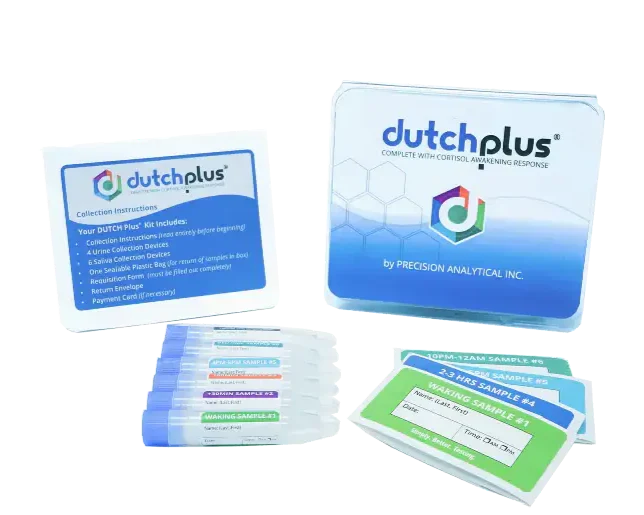
The DUTCH Test: What It Measures and How It Fits Into Modern Hormone Health
The DUTCH test (available on PureClean Performance from Dr. Rick Cohen, M.D.)— short for Dried Urine Test for Comprehensive Hormones — has become a popular functional medicine tool for evaluating hormone balance. It’s marketed as a more comprehensive and convenient alternative to traditional hormone testing methods such as blood or saliva tests. But what exactly does it measure, how does it work, and is it worth it?
How the DUTCH Test Works
The DUTCH test uses four to five dried urine samples collected over a 24-hour period. These samples are analyzed for sex hormones, adrenal hormones, and their metabolites — including estrogen (estradiol, estrone, estriol), progesterone, testosterone, DHEA-S, cortisol, and melatonin. It can also include organic acids that reflect nutritional status, oxidative stress, and neurotransmitter activity.
Unlike a one-time blood draw, the DUTCH test captures hormone production and metabolism throughout the day, offering a “moving picture” of hormonal rhythm and clearance. For instance, it can show how cortisol levels fluctuate over a 24-hour cycle, revealing stress-adaptation patterns that a single morning cortisol reading might miss.
Advantages and Unique Insights
Supporters argue that the DUTCH test provides a more complete picture of hormonal health by measuring both parent hormones and their metabolites. This allows clinicians to see how effectively the body is converting and detoxifying hormones. It’s particularly valued for:
- Assessing estrogen dominance or slow estrogen clearance
- Evaluating adrenal fatigue or HPA-axis dysfunction
- Understanding testosterone metabolism in both men and women
- Monitoring hormone replacement therapy (HRT) response
- Correlating hormonal data with symptoms like fatigue, mood swings, or weight changes
Limitations and Scientific Debate
Despite its growing popularity, the DUTCH test is not without controversy. As of 2025, it remains not FDA-cleared, and while internal studies suggest reliability for certain metabolites, large-scale peer-reviewed validation is limited. Critics — including some endocrinologists and academic physicians — caution that interpretation can vary and that correlations between dried urine markers and true physiological states are not yet fully standardized.
Independent experts from institutions such as the University of Colorado and various endocrinology associations note that dried urine hormone testing may overestimate or underestimate active hormone availability in specific populations, and should not replace clinical judgment or standardized testing for diagnosis of endocrine disorders.
Cost, Convenience, and Accessibility
The DUTCH test typically costs between $300–$700 depending on the panel. It’s performed at home using a mailed kit and is not covered by most insurance plans. The dried format makes it simpler than a full 24-hour urine collection, though specific prep steps—such as avoiding caffeine, alcohol, and certain supplements—are required.
How to Decide if It’s Right for You
Consider the DUTCH test if you’ve experienced persistent symptoms such as fatigue, low libido, poor sleep, mood changes, or irregular cycles and standard blood tests have come back “normal.” It’s often used by functional and integrative practitioners to map hormonal resilience and identify metabolic stress patterns before overt pathology develops.
However, results should ideally be reviewed with a qualified clinician experienced in hormone interpretation, as overreliance on uncontextualized numbers can lead to overtreatment or unnecessary supplementation.
Integrating Results Into Your Health Plan
Whether you pursue the DUTCH test or stick with traditional labs, hormone balance thrives on foundational work: nutrient sufficiency, circadian alignment, hydration, stress management, and mitochondrial support. Data-driven supplementation — such as magnesium, adaptogens, or mitochondrial cofactors — can then be layered strategically, not reactively.
PureClean Performance emphasizes this same principle: measure, don’t guess. By combining validated biomarkers, breath-hold or HRV readiness metrics, and nutrient optimization, you can build a truly personalized blueprint for endocrine and mitochondrial health.
Learn More at DUTCHTest.com Explore Foundational Nutrient SupportReferences & Further Reading
- Precision Analytical: Official DUTCH Test Site
- Anzara Health: Is the DUTCH Test Legitimate? (2024)
- Natural Womanhood: Effective Tool or Passing Fad?
- Allara Health: The DUTCH Test for Hormones: Is It Worth It?
- CU Medicine / Colorado Women’s Health: Clinical Perspective on DUTCH Testing
